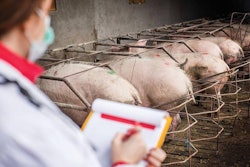
Native grass consumption achieves higher milk yields and lower greenhouse gas emissions
Scientists report that it is possible to increase milk production from small dairy herds in Kenya, and have a positive impact on the environment.
Key to the achievement of higher milk yields and lower greenhouse gas (GHG) emissions was to feed the cows on native grass, according to the multinational research team.
African Napier grass (Pennisetum purpureum) is a nutrient-rich forage that can be cultivated on the farm, sparing nearby forests from overgrazing. Cows fed this grass had higher milk yields, yet the GHG emissions from the system were lower than traditional free grazing systems, the scientists found.
Increased intensification in animal agriculture is often associated with adverse environmental impacts. This was not the case in this study, which involved modeling the impacts of three different dairy cow feeding scenarios in Kenya on GHG emissions. The model chosen allowed for consideration of the effects of the systems on land use.
Kenya’s 2 million dairy smallholders — defined in the study as having no more than 10 cows — allow their animals to graze local grassland and forests in common ownership, according to the University of Lancaster. This grazing pressure reduces the ability of the forest to act as a carbon sink, and to regenerate after being cleared.
Options for forage cultivation, feeding
The researchers modeled the effects of three different production systems, which included feeding the cows either native Napier grass, or corn silage, or a combination of both forages. All options involved feeding small amounts of concentrate to the cows during the dry season.
The grass was cultivated locally, requiring little soil disturbance and only manure as a fertilizer. Corn production required the application of some artificial fertilizer.
Compared with the traditional system, all three higher-nutrient feeding options increased milk yields — by 44-51%. As well as the improvement in yield, feeding the Napier grass alone reduced overall GHG emissions by 2.5%. Emissions per unit milk produced were slightly lower with the grass-corn combination than the current grazing regime. Taking into account the land use change, the cultivation and feeding of corn silage increased overall emissions.
The paper — titled “Intensification of dairy production can increase the GHG mitigation potential of the land use sector in East Africa” – has been published in the journal Global Change Biology.
Lead author of the paper was Patric Brandt from the Centre for International Forestry Research (CIFOR) in Kenya. Co-authors were Gabriel Yesuf (University of Lancaster in the United Kingdom, U.K.), Professor Martin Herold (Wageningen University in the Netherlands), and Professor Marina Rufino (Lancaster Environment Centre, U.K.).
Researchers urge caution over dairy intensification
Intensification of dairy production in a low-income country can increase milk yields without increasing emissions, the researchers concluded from their study.
“Increasing milk production really matters in Africa because even a small amount of milk can make a huge difference to a young child in terms of brain development, micronutrients and growth, particularly in the under-fives,” Rufino said.
She added that dairy production is a year-round activity — unlike some crops — that helps to empower women. It also generates additional income for medicines and education.
“Intensification of the current Kenyan dairy sector, if done properly, can reduce emissions from the forest sector and so overall emissions,” Herrold said. “We believe this has implications for small dairy farms all over East Africa since both food security and enhancing forests are high on national policy agendas.”
However, he warned that this “win-win” situation can only be achieved if agricultural policy and forestry policy are coordinated. Carbon emission reductions will likely not be achieved if the dairy sector expands overall, or switches to more intensive production, he said.
In assessing the environmental impact of dairy farming, the research group stressed the importance of including all emissions in the calculation. This includes those resulting from land use changes and feed production, and not only those from the farm.
Dairy development varies across Kenya
Within Kenya, dairy farmers have been subject to mixed fortunes in recent times. Those in a central region have been able to raise output, supported by regular milk collections that guarantee a market for their product. Elsewhere, the sector is held back by poor product quality, imports of dairy products, and widespread aflatoxin contamination of feeds.
According to the Kenya Dairy Board, the country’s dairy cow population stands at 4.5 million dairy cows. Of the 5.28 billion liters of milk produced each year, only around 11% is formally marketed.
















